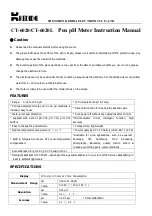
EATON ELECTRICAL
31
Predictive Diagnostics
2.2.3.4
Coax cables connections.
Tie all cables together by tie-wrap at the top of the hub inside the device enclosure.
Using the coax cable stripper for RG58 cable (IDEAL part#
45264
STRIP MASTER for
RG58 coax cable, Newark catalog#05H8227 or similar) strip the outer PVC jacket to the
distance of 1-inch, unbraid the shield and remove the inner conductor insulation to the
distance of about 0.3-inch, twist shield wires to avoid “hairs” and crimp the blade
terminal to the shield. Cut stick out hairs to avoid short-circuiting. Do not use a blade to
connect the signal (central) conductor.
Figure 7.
Connect the cables to their respective terminals at the Sensor Interface Board.
Distribute cables evenly and secure them in place (Figure 3.).
Certain connections to InsulGard, such as the connections of the power supply, RS-485
Interface, 4-20 mA output, and the output relays utilize molded connectors supplied with
the kit. All these connectors are pre-wired to the terminal board (refer to Figure 2 and
Figure 6) except of the flash mount option.
2.2.3.5
Step 4 - Device Installation and Final Connections
•
Connect the voltage sensor to the PT secondary at this time.
•
Check with a DMM for the existence of signals across the respective terminals at the
TB-3 terminal board: voltage channel (up to 6V AC), current channel (up to 0.6V
AC). Check the resistance between respective RTD terminals of TB-3 terminal
board.
•
Check that the flat ribbon cable is connected to InsulGard inside its enclosure. Make
sure that all connector latches are in vertical position (locked).
•
Install InsulGard and fasten it to the standoffs with the supplied screws.
•
Check that the 3-pin output relay terminal blocks are inserted in their respective
terminals on the right side of InsulGard. The relay outputs are, from top to bottom:
P1– Red (alarm)
P2– Yellow (warning)
P3 – Device status
















































